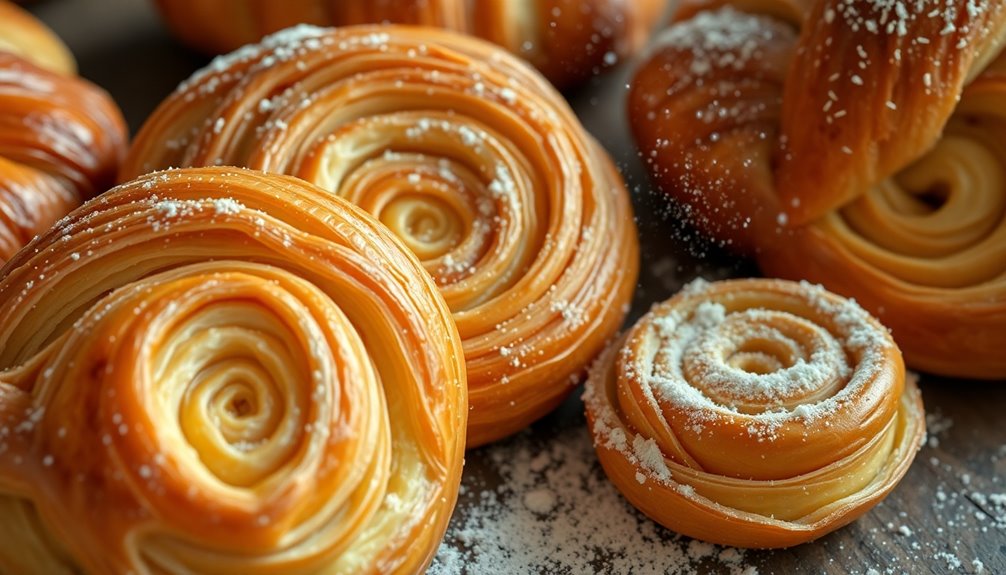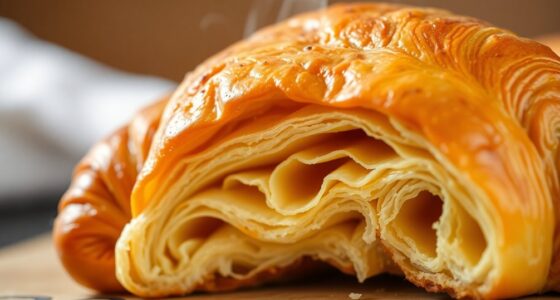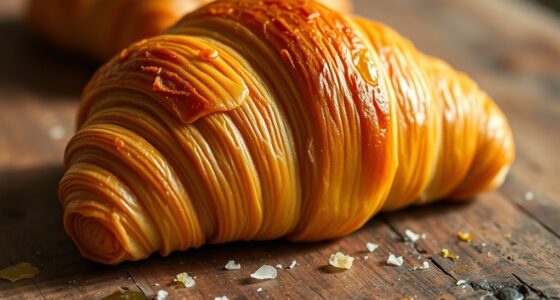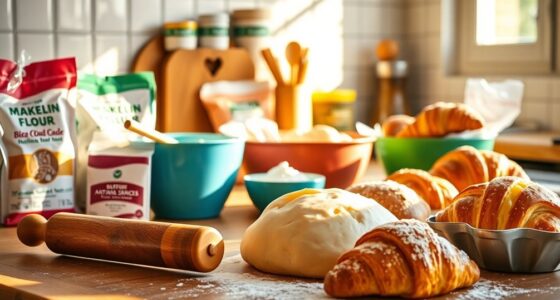In the art of laminated dough, cold butter plays an essential role in achieving the flaky textures of croissants and danishes. By folding layers of cold butter into your dough, you create steam pockets that puff up each layer while baking. Using quality butter with at least 82% fat content guarantees a rich, airy result. Understanding this magical process is just the beginning; there's so much more to master about making perfect pastries.
Key Takeaways
- The quality of butter, with at least 82% fat content, is crucial for achieving flakiness in croissants and danishes.
- Proper lamination involves folding cold butter into dough, creating layers that puff up during baking.
- Each fold and roll enhances the dough structure, forming a honeycomb texture essential for flaky pastries.
- Temperature control is vital; keeping butter cold prevents melting and ensures the desired flaky texture.
- Using specialized tools like a French rolling pin and perforated baking sheets improves dough handling and baking results.
The Science Behind Laminated Dough
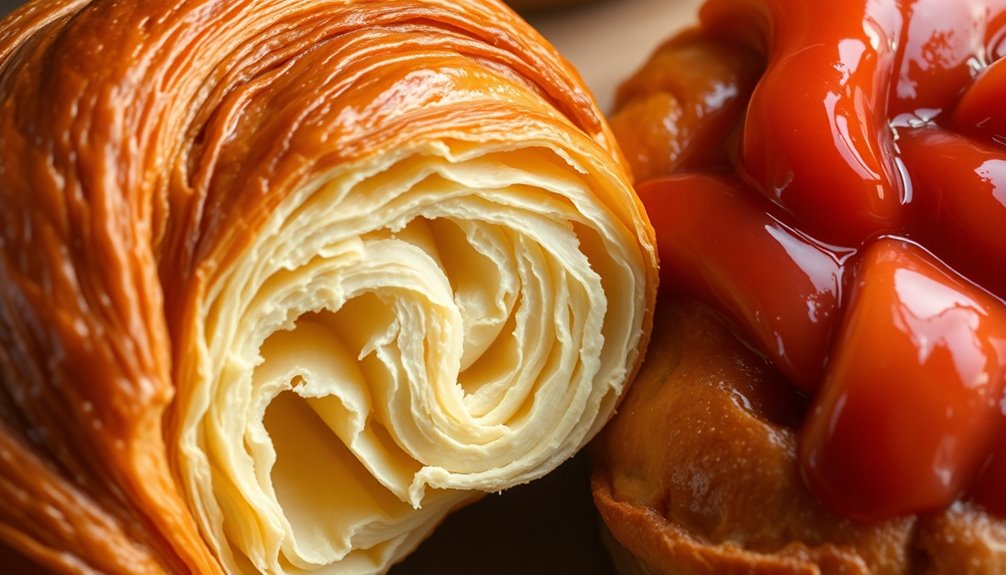
When you plunge into the world of laminated dough, you'll discover that its signature flaky texture and airy structure come from a meticulous process of folding and rolling cold butter into the dough.
The butter must have a high fat content, ideally at least 82%, ensuring it remains solid during lamination. This is essential; if the butter melts, you risk losing that desired flakiness.
As you bake, the water in the butter vaporizes, creating steam pockets that form the puffed pastry and the open honeycomb structure characteristic of croissants and pastries.
Each fold and roll adds layers, enhancing the dough's structure and texture. Mastering this process is fundamental for achieving the perfect flaky layers you crave in your baked goods.
Step-by-Step Guide to Making Laminated Dough
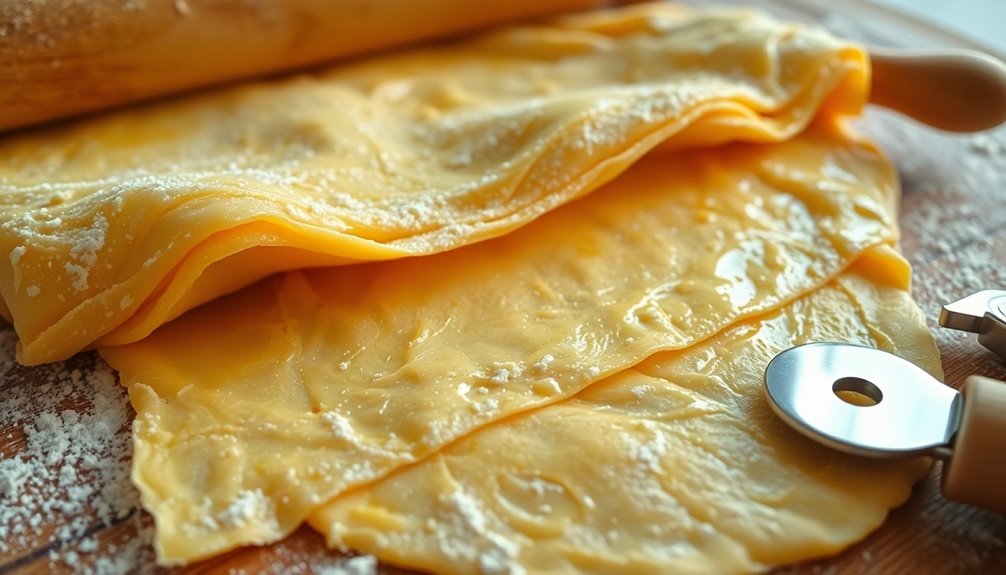
Creating laminated dough might seem intimidating, but it's a rewarding process that leads to the flaky, tender pastries you love.
Start by mixing flour, sugar, salt, and yeast with melted butter and milk, then refrigerate the dough for at least 2 hours. Shape your cold butter into a 7 1/2-inch square, keeping it chilled for ideal lamination.
Next, roll out the dough and enclose the butter block by folding the corners over it. Perform a series of rolling and folding—roll into a 24 x 12-inch rectangle and fold into thirds, repeating this two more times.
Always keep the dough cool and rest it as needed to prevent the butter from melting, ensuring that signature flaky texture in your croissants and pastries. Using unsalted butter is essential for controlling salt levels and achieving the best flavor in your laminated dough.
Essential Techniques for Perfect Lamination
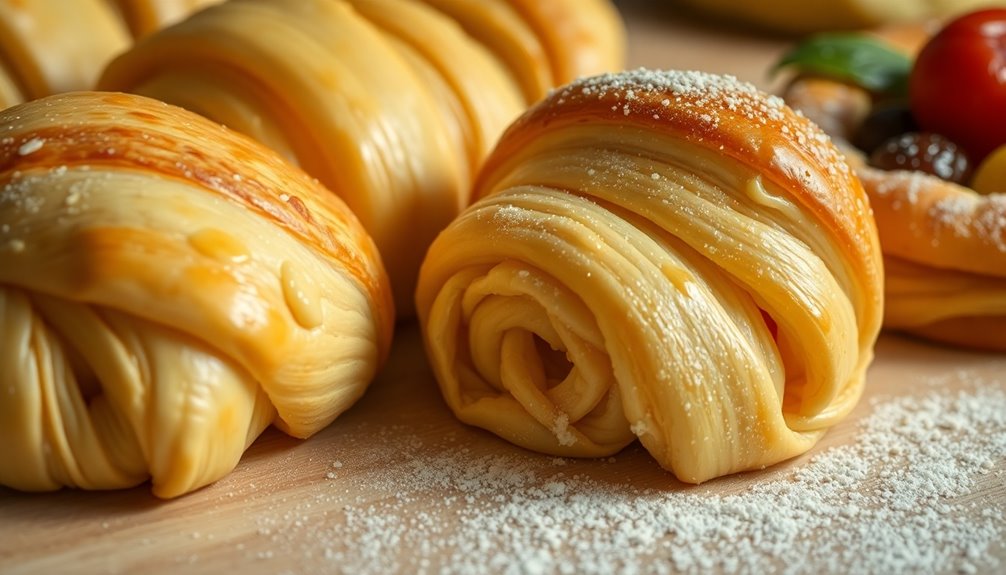
To achieve perfect lamination, it's necessary to incorporate cold butter into your dough effectively, as this maintains its solid state during the rolling process.
Start by using high-quality butter with at least 82% fat content, which enhances the flaky texture of your pastries. Roll your dough into a rectangle, folding it strategically to create hundreds of thin layers of butter and dough.
Remember, resting periods between folds are vital; they help prevent the butter from melting, which could compromise your layers. Use a classic French rolling pin for better control and consistency.
These important techniques will guarantee your laminated dough results in beautifully flaky croissants and Danishes that are sure to impress.
The Role of Butter in Croissants and Danishes
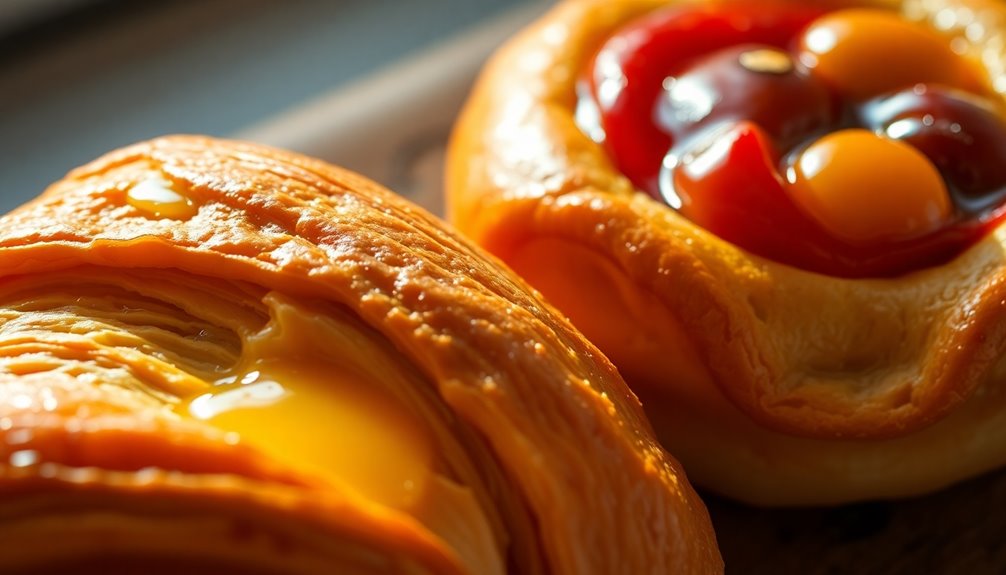
Mastering the technique of lamination sets the stage for understanding the essential role butter plays in croissants and Danishes.
The quality of butter is vital; choose options with at least 82% butterfat content to enhance the pastry's flakiness and richness. As you bake, the water in the butter vaporizes, creating steam that puffs up the layers, contributing to the airy texture you crave in these treats.
Keeping the butter solid during lamination is key; if it melts, you'll end up with a denser, bread-like texture. The intricate layering of butter and dough forms a honeycomb structure, giving croissants their iconic lightness and crispy exterior while ensuring a rich mouthfeel that makes these pastries irresistible. Additionally, using clarified butter can further improve the texture and flavor of your laminated dough creations.
Recommended Butters for Optimal Results
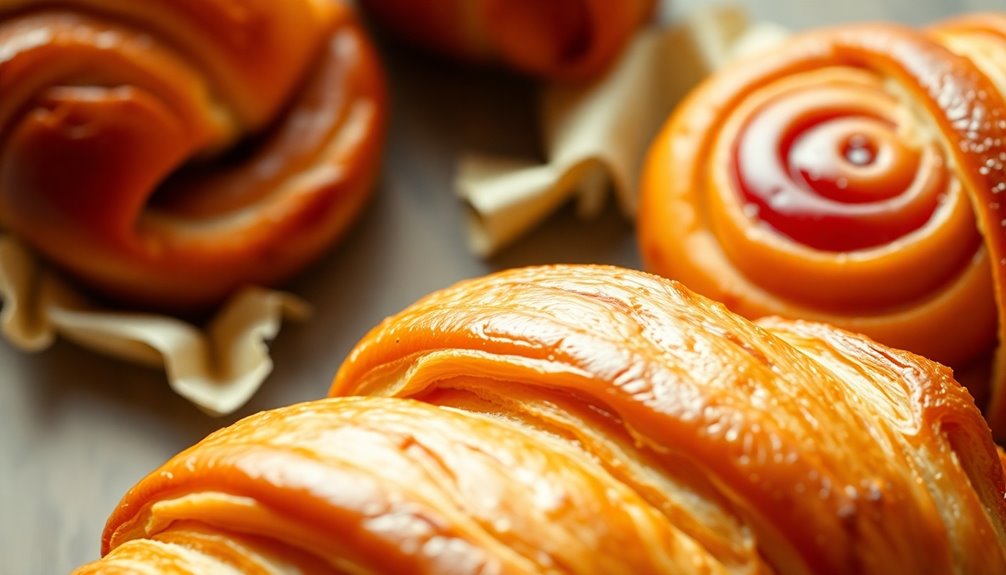
When it comes to laminated dough, the butter you choose can make or break your results.
Look for high butterfat content, like Isigny Sainte-Mère or Minerva Dairy, to guarantee your croissants and Danishes are rich and flaky.
The texture and flavor of your pastries will greatly improve with quality butter, so don't skimp on this essential ingredient.
Butterfat Content Matters
Butterfat content plays an essential role in achieving the perfect lamination for croissants and Danishes. For best results, you need butter with at least 82% butterfat.
Isigny Sainte-Mère butter, sourced from grass-fed cows, delivers a rich flavor in convenient blocks and sheets, making it ideal for laminated dough.
Beurremont butter, with an impressive 83% butterfat, is known for its quality, even serving as the official butter for Team USA at the Bocuse d'Or.
Minerva Dairy butter, featuring 85% butterfat, offers a creamy texture but requires careful handling due to its tendency to soften.
Finally, Plugrá butter, a budget-friendly European-style option, also has 82% butterfat but needs temperature management to prevent brittleness during lamination.
Regional Butter Recommendations
Choosing the right butter can make all the difference in your laminated dough creations. For ideal results in croissants and pastries, consider these high-quality butter options:
- Isigny Sainte-Mère Butter: With 82% butterfat from grass-fed cows, it delivers a rich flavor perfect for laminated dough.
- Beurremont Butter: This Vermont-made butter boasts 83% butterfat and is the official choice for Team USA in the Bocuse d'Or competition, ensuring superior quality.
- Minerva Dairy Butter: With an impressive 85% butterfat, it's known for a super-creamy texture, though it requires careful handling due to its quick softening.
Selecting high-quality butter with a minimum of 82% fat content is key to achieving that flaky, buttery texture you crave in your pastries.
Texture and Flavor Impact
Selecting the right butter greatly affects the texture and flavor of your laminated dough. High butterfat content is essential; aim for at least 82% to achieve those flaky layers you crave in croissants and pastries.
Isigny Sainte-Mère butter, with its rich 82% butterfat from grass-fed cows, enhances both texture and flavor beautifully. Professionals often choose Beurremont butter, boasting 83% butterfat, for its superior performance.
Minerva Dairy's 85% butterfat butter offers a creamy richness but requires careful handling due to its quick softening. If you're looking for an affordable option, Plugrá butter provides 82% butterfat but can become brittle when cold.
Choosing the right butter guarantees your laminated dough turns out deliciously flaky and flavorful every time.
Creative Variations and Recipes With Laminated Dough
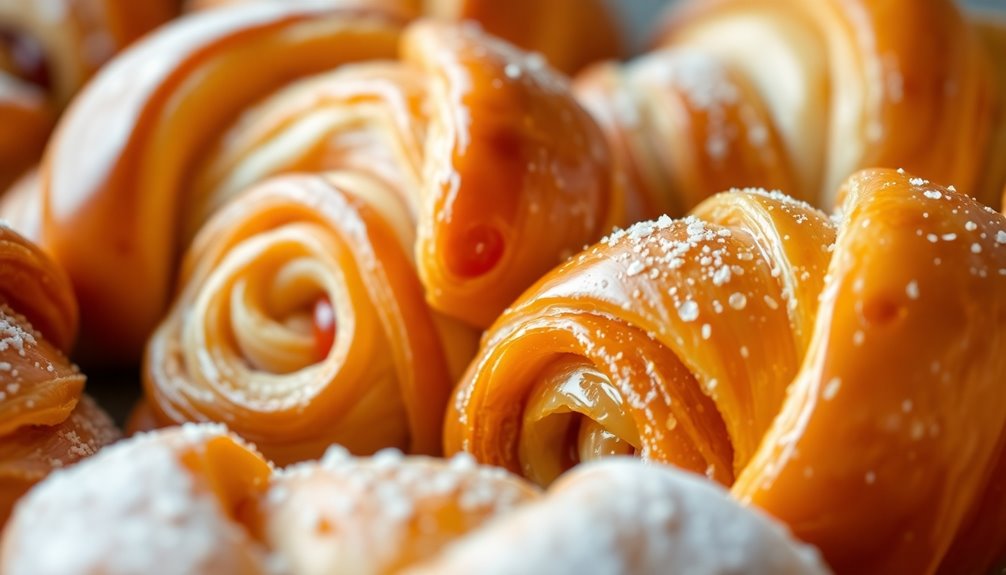
While exploring the world of laminated dough, you'll discover a plethora of creative variations that elevate traditional pastries into something extraordinary.
With its versatile nature, you can customize pastries to suit your tastes and seasonal ingredients. Here are three delightful options to try:
- Pain au Chocolat: Indulge in flaky layers encasing rich chocolate for a classic treat.
- Fruit Danish: Use seasonal fruits or cream cheese fillings to add a revitalizing twist.
- Almond Tuiles: Create crunchy tuiles for a delightful contrast to your soft pastries.
Don't hesitate to experiment with different shaping techniques, like knots or spirals, to enhance visual appeal and texture while incorporating unique fillings. Additionally, the choice of butter's role in culinary traditions can significantly influence the flavor and texture of your baked goods.
The possibilities are endless with laminated dough!
Tools and Equipment for Successful Lamination
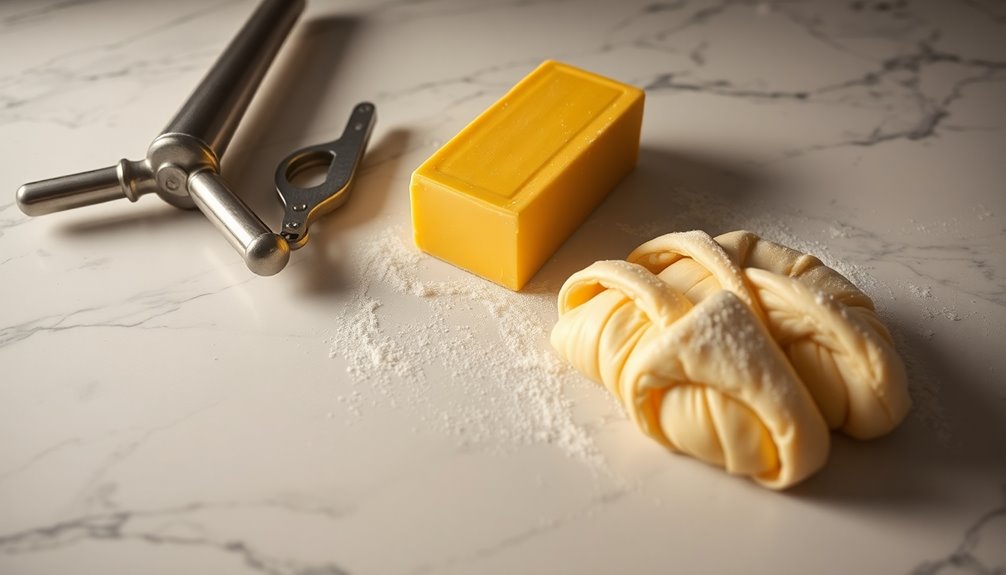
To create perfect laminated dough, having the right tools and equipment can make all the difference. Start with a classic French rolling pin, about 20 inches long, to guarantee straight edges and square corners. A perforated baking sheet promotes even cooking, giving your croissants the perfect texture. You'll also need a high-quality egg wash brush, like the Carlisle model, for precise application without drips. Consider a clay slab roller for consistent pressure without warming the dough, enhancing the lamination. Finally, make a makeshift proofing box using a bowl of hot water to mimic controlled proofing environments. Additionally, investing in smart home technology can optimize your kitchen environment for baking by ensuring energy efficiency through smart utilities.
| Tool | Purpose | Benefits |
|---|---|---|
| French Rolling Pin | Roll dough evenly | Better control |
| Perforated Baking Sheet | Enhance air circulation | Even cooking |
| Egg Wash Brush | Apply egg wash | Precision without drips |
| Clay Slab Roller | Roll without heat | Improved lamination |
| Makeshift Proofing Box | Control humidity/temperature | Better dough elasticity |
Tips for Troubleshooting Common Issues
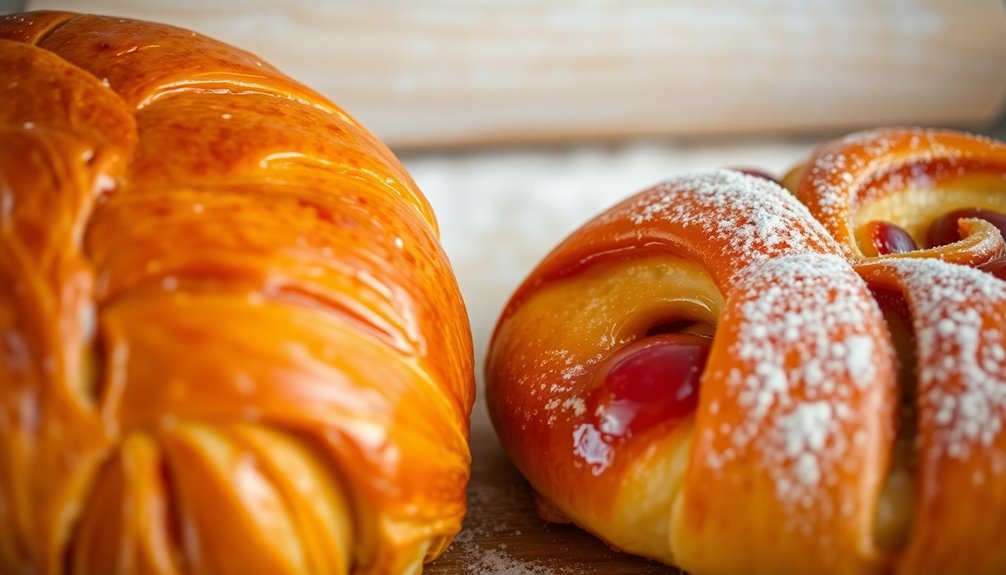
When you encounter issues with laminated dough, addressing them promptly can save your batch from disaster. Here are some tips to troubleshoot common problems with your yeasted pastry for croissants and danishes:
- Keep butter cold: If your butter melts during the lamination process, your pastries may turn out bready instead of flaky.
- Manage gluten: If the dough feels too elastic and hard to roll, allow it to rest longer in the refrigerator to relax the gluten.
- Ensure even baking: Use perforated baking sheets for better air circulation, preventing uneven baking and overly dark bottoms.
Also, remember to apply your egg wash carefully and check your oven temperature to promote proper steam expansion for delightful laminated pastries!
Frequently Asked Questions
Which Type of Laminated Dough Is Used for Making Croissants and Danishes?
They say, "You can't make an omelet without breaking eggs," and the same goes for delicious pastries!
For croissants and Danishes, you use a rich, buttery laminated dough. This dough combines flour, water, salt, sugar, and yeast, layered with high-quality butter.
The magic happens when you fold and roll it, creating those flaky layers that puff beautifully in the oven. Your patience and technique will reward you with mouthwatering results!
What Makes Laminated Dough so Special?
Laminated dough's special because of its unique structure, featuring hundreds of thin layers that create a flaky, airy texture.
You fold and roll butter into the dough, trapping it between layers. This process prevents a dense texture, ensuring each bite is light and crisp.
The quality of the butter you use matters, too; higher fat content results in a richer flavor and better flakiness.
When baked, steam from the butter puffs up the pastry beautifully.
What Is the Croissant Technique Called?
Think of the croissant technique as a delicate dance between dough and butter. This process is called "lamination."
You're layering cold butter into a basic dough, folding and rolling it to create that signature flaky texture. Each fold adds a layer, much like pages in a book, resulting in hundreds of thin layers.
Mastering this technique is essential for achieving that light, airy structure you crave in your pastries.
What Is the Difference Between Croissant Dough and Danish Dough?
The difference between croissant dough and Danish dough lies in their ingredients and texture.
Croissant dough is simpler, using flour, water, yeast, salt, and a lot of butter, giving it a flaky, airy structure.
On the other hand, Danish dough includes milk, sugar, and eggs, resulting in a richer, sweeter flavor and a softer crumb.
The lamination process also varies, with Danish dough often requiring more folds for that desired layered effect.
Conclusion
You've journeyed through the art of laminated dough, discovering its science and mastering essential techniques. As you roll out your creations, you might just find that perfect croissant or danish waiting for you in your oven, golden and flaky. Coincidentally, every bite will remind you why butter is truly magical. So, gather your tools, release your creativity, and embrace the delicious surprises that come with each layer. Happy baking—you're about to impress everyone with your newfound skills!
